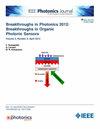Analysis of Mode Characteristics in Semiconductor Lasers With Asymmetric Coupled Cavities Based on Quasi Parity-Time
IF 2.1
4区 工程技术
Q3 ENGINEERING, ELECTRICAL & ELECTRONIC
引用次数: 0
Abstract
This study presents a novel asymmetrically coupled cavity (ACC) semiconductor laser structure designed to achieve stable single-mode operation in wider ridge waveguides, enhancing output power. The proposed structure consists of a gain ridge waveguide and an electrically insulated lossy ridge waveguide, enabling flexible control of transverse modes through the coupling effect between the fundamental mode of the lossy waveguide and the first-order mode of the gain waveguide. By optimizing key parameters—ridge waveguide width, spacing, and etching depth—the ACC forms a new optical mode distribution that suppresses higher-order modes through significant optical loss in the lossy section while the fundamental mode remains confined to the gain waveguide. The newly defined variables—the optical field proportion factor and the modal regulation factor—quantify the loss characteristics of higher-order modes. Combined with the influence of propagation length on the control of ACC coupling modes, the optimal range for structural parameters in achieving single-mode operation can be determinate.基于准宇称时间的非对称耦合腔半导体激光器模式特性分析
本文提出了一种新的非对称耦合腔(ACC)半导体激光器结构,可以在更宽的脊波导中实现稳定的单模工作,提高输出功率。该结构由增益脊波导和电绝缘损耗脊波导组成,通过损耗波导的基模和增益波导的一阶模之间的耦合效应实现横向模式的灵活控制。通过优化关键参数——脊波导宽度、间距和蚀刻深度,ACC形成了一种新的光模式分布,通过损耗部分的显著光损耗抑制高阶模式,而基模仍然局限于增益波导。新定义的光场比例因子和模态调节因子量化了高阶模的损耗特性。结合传播长度对ACC耦合模式控制的影响,可以确定实现单模工作时结构参数的最优范围。
本文章由计算机程序翻译,如有差异,请以英文原文为准。
求助全文
约1分钟内获得全文
求助全文
来源期刊

IEEE Photonics Journal
ENGINEERING, ELECTRICAL & ELECTRONIC-OPTICS
CiteScore
4.50
自引率
8.30%
发文量
489
审稿时长
1.4 months
期刊介绍:
Breakthroughs in the generation of light and in its control and utilization have given rise to the field of Photonics, a rapidly expanding area of science and technology with major technological and economic impact. Photonics integrates quantum electronics and optics to accelerate progress in the generation of novel photon sources and in their utilization in emerging applications at the micro and nano scales spanning from the far-infrared/THz to the x-ray region of the electromagnetic spectrum. IEEE Photonics Journal is an online-only journal dedicated to the rapid disclosure of top-quality peer-reviewed research at the forefront of all areas of photonics. Contributions addressing issues ranging from fundamental understanding to emerging technologies and applications are within the scope of the Journal. The Journal includes topics in: Photon sources from far infrared to X-rays, Photonics materials and engineered photonic structures, Integrated optics and optoelectronic, Ultrafast, attosecond, high field and short wavelength photonics, Biophotonics, including DNA photonics, Nanophotonics, Magnetophotonics, Fundamentals of light propagation and interaction; nonlinear effects, Optical data storage, Fiber optics and optical communications devices, systems, and technologies, Micro Opto Electro Mechanical Systems (MOEMS), Microwave photonics, Optical Sensors.
 求助内容:
求助内容: 应助结果提醒方式:
应助结果提醒方式:


